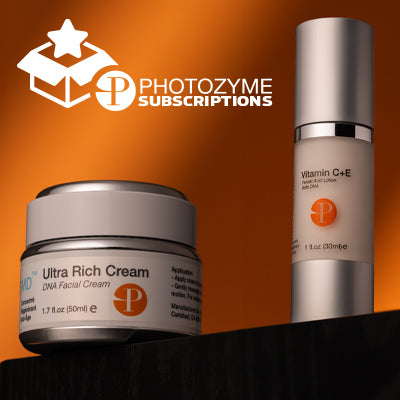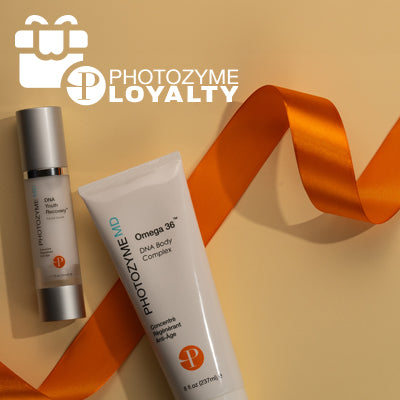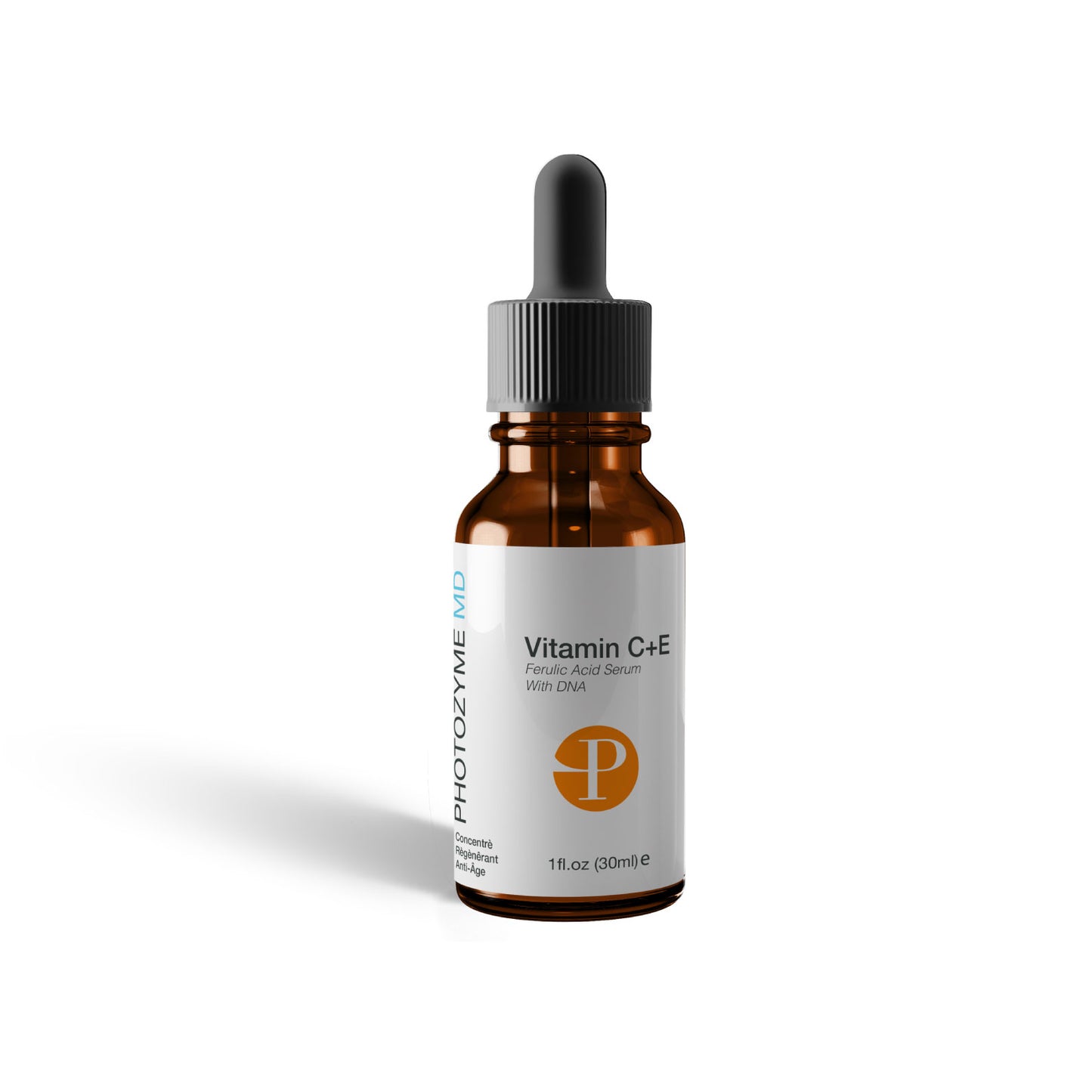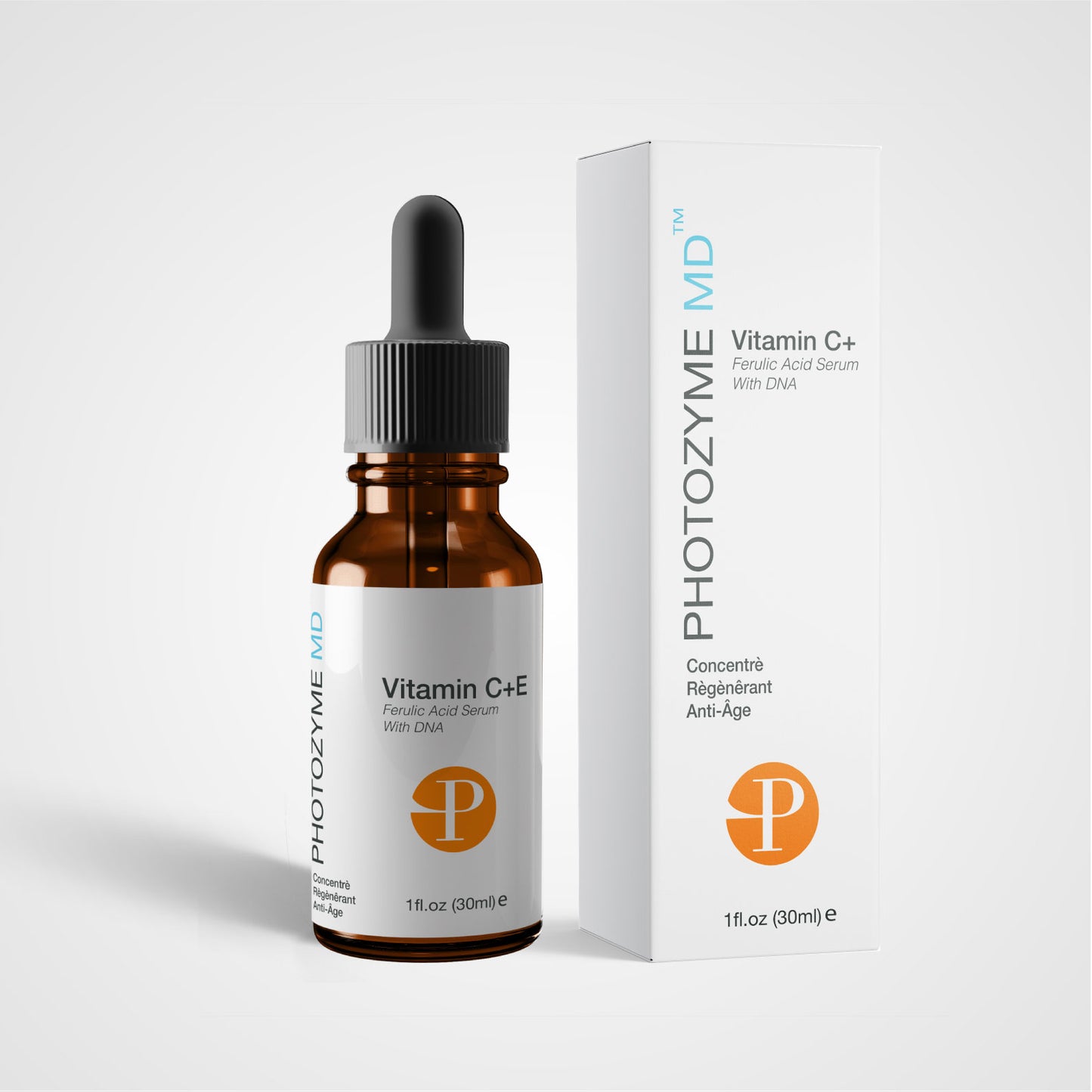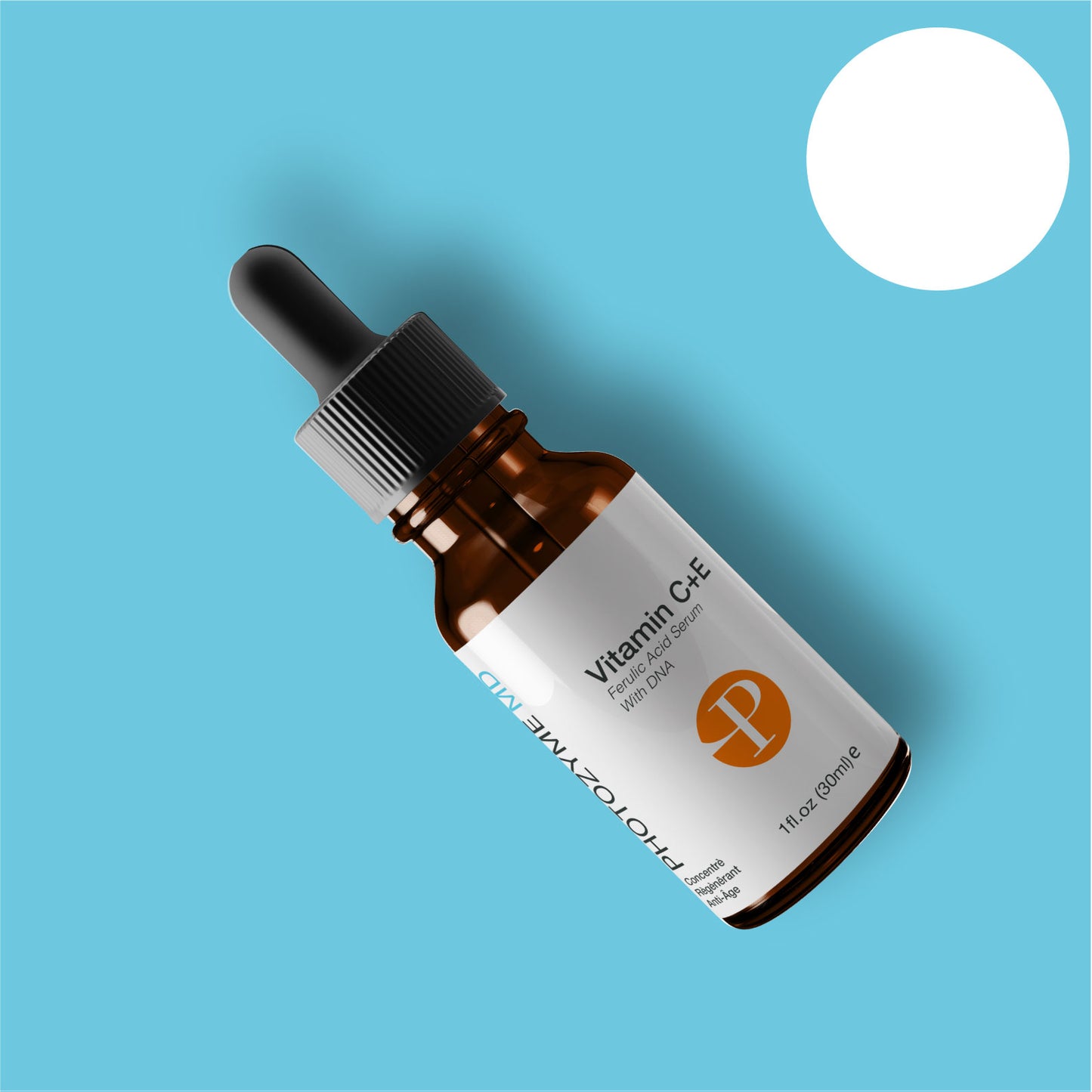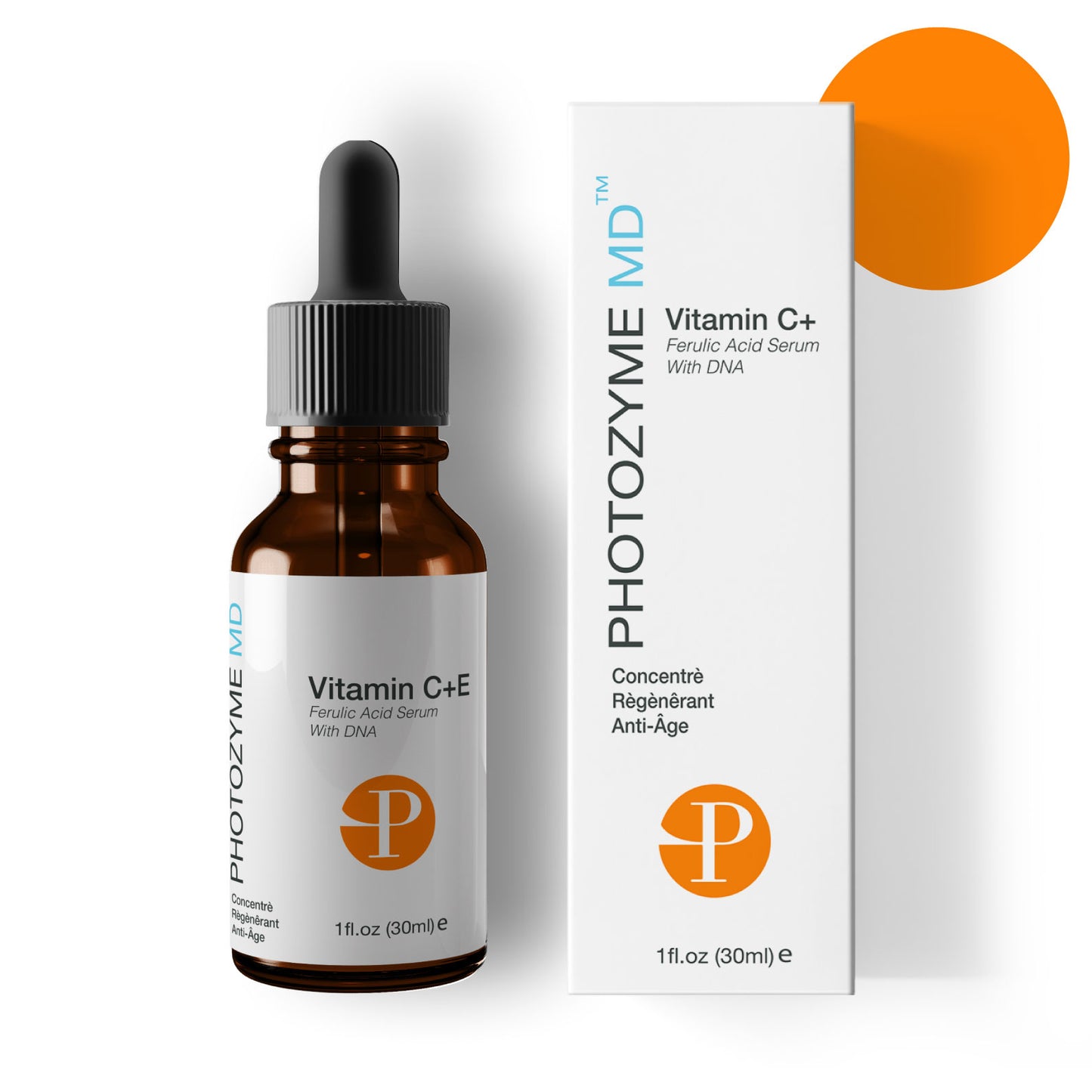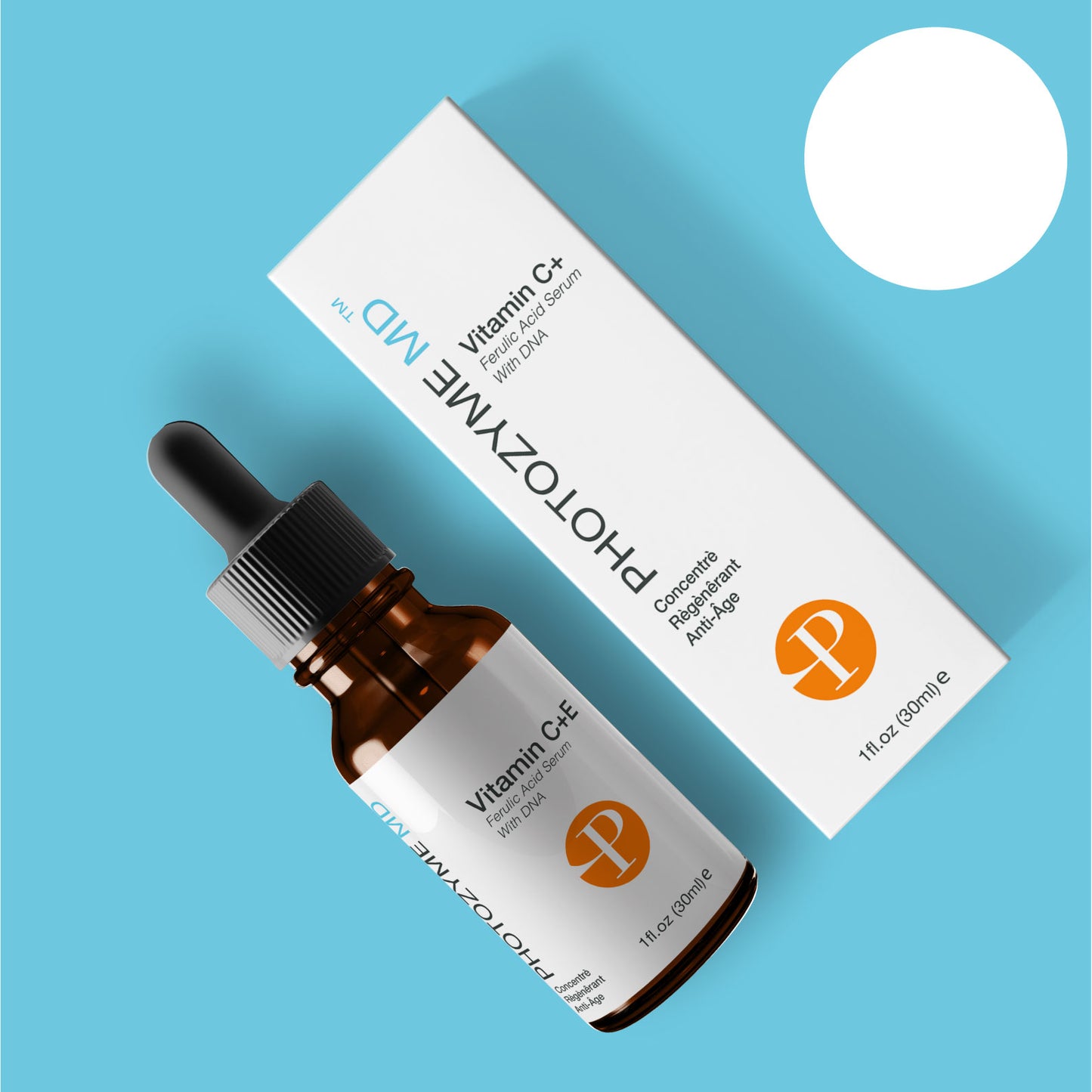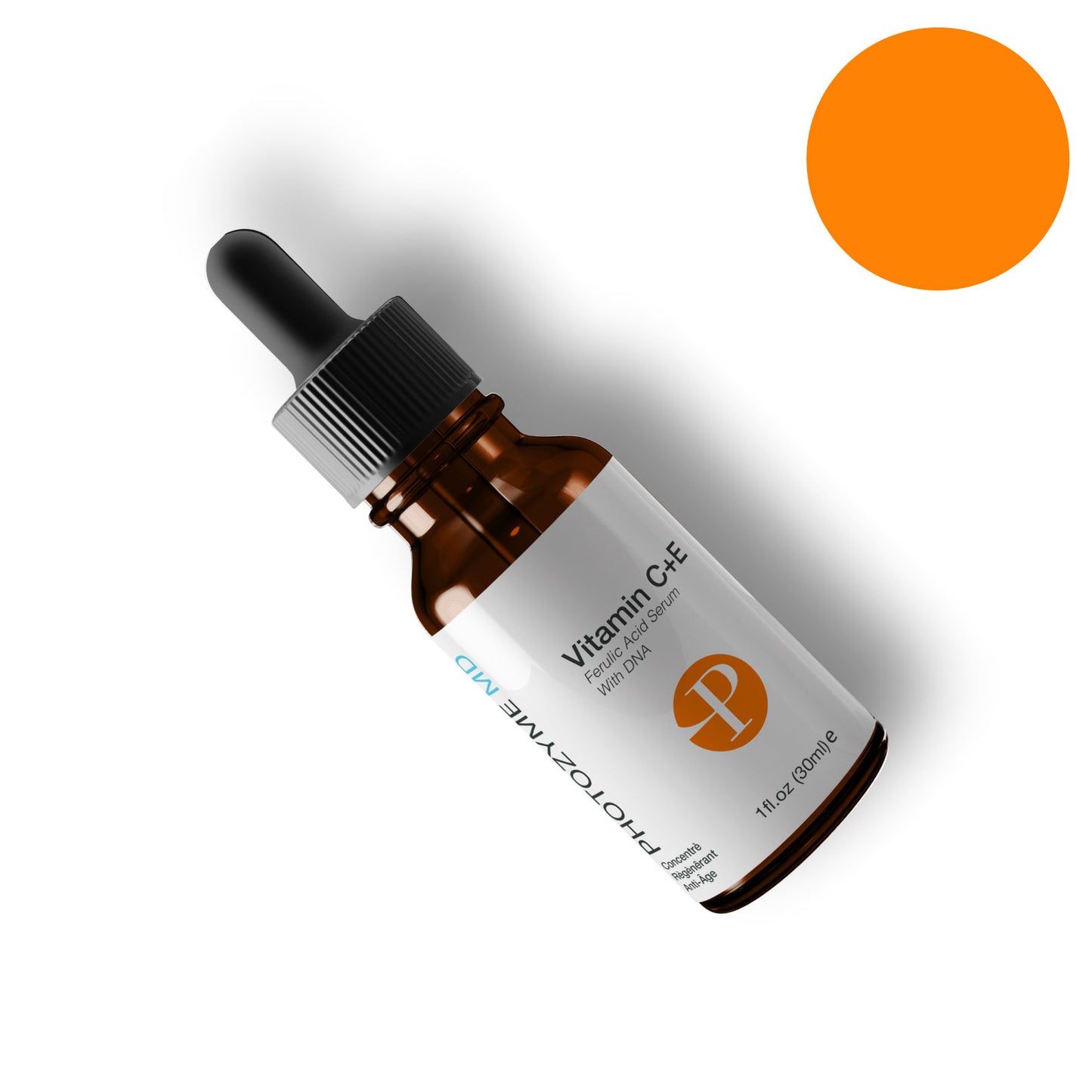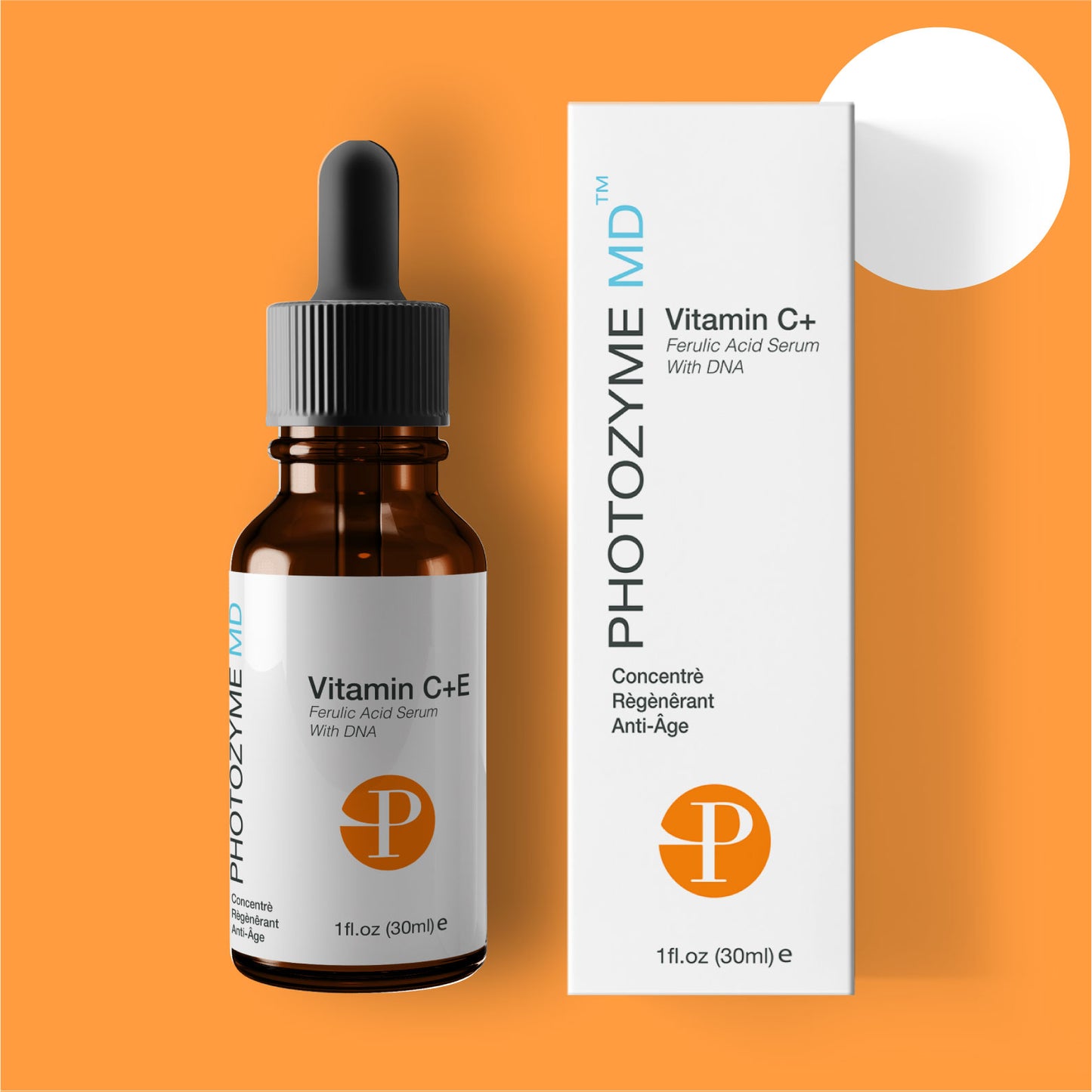This store requires javascript to be enabled for some features to work correctly.
Ferulic Acid Serum
A ferulic acid serum is the backbone of a defense strategy that works deeper than the surface. Known for its ability to stabilize and enhance other actives like vitamin C and E, ferulic acid is key in reinforcing your skin’s resilience against UV and pollution stress. If your routine is missing that layer of environmental protection, it might be time to rethink what your antioxidant blend is really doing.
Vitamin C+E Ferulic Acid Serum with DNA 1 fl oz
Treat yourself to firmer and healthier looking skin you deserve with this amazing skin treatment product containing 15% L-ascorbic acid (vitamin C), 1% vitamin E, 0.5% ferulic acid and loaded with DNA Repair Enzymes. This expertly formulated serum fights visible signs of aging, including wrinkles, fine lines, dark spots and sun damage with the nourishing power of Vitamin C, Vitamin E, Ferulic Acid and DNA Repair Enzymes.
Benefits
- Stimulates collagen growth, naturally plumping up aging skin
- Reduces the visibility of fine lines and wrinkles
- Fades sun damage and dark spots
- Protects skin from photodamage and infrared radiation
- Neutralizes skin-damaging free radicals
- Brightens skin complexion and evens out skin tone and texture
Ingredients
WATER (AQUA), ETHOXYDIGLYCOL, ASCORBIC ACID, PROPYLENE GLYCOL, GLYCERIN, SODIUM HYALURONATE, PANTHENOL, LAURETH-23, FERULIC ACID, PHOTOLYASE (ANACYSTIS NIDULANS), ENDONUCLEASE (MICROCOCCUS LUTEUS),GLYCOSYLASE (ARABIDOPSIS THALIANA), TOCOPHEROL, PHENOXYETHANOL, ETHYLHEXYGLYCERIN, TRIETHANOLAMINE
Directions
Apply serum to clean face in the morning. Apply to the entire face and neck area in upward and outward stroke.
Shipping
Free shipping on US orders over $50
What Is Ferulic Acid And Why Your Skin Needs It
Ferulic acid is a potent plant-derived antioxidant found naturally in the seeds and cell walls of grains, fruits, and vegetables. In skincare, it is recognized for its remarkable ability to neutralize free radicals, unstable molecules generated by UV rays and environmental stressors that accelerate skin aging at the cellular level.
When introduced into topical serums, ferulic acid stabilizes other antioxidants, such as vitamins C and E, amplifying their efficacy and extending their shelf life. This unique synergy shields skin from oxidative damage, helping to slow the formation of fine lines, wrinkles, and hyperpigmentation. Numerous clinical studies have demonstrated that ferulic acid can significantly boost the skin's defense mechanisms, making it a staple ingredient for those committed to a science-driven anti-aging routine.
Beyond its antioxidant properties, ferulic acid supports the skin’s natural repair processes. By curbing the cascade of inflammation triggered by UV exposure, ferulic acid assists in preserving collagen integrity and skin barrier function. For professionals and individuals dedicated to age-preventive skincare, incorporating a ferulic acid serum is an evidence-backed strategy to protect, fortify, and rejuvenate the skin in the face of daily environmental challenges.
Application Protocol: Order, Frequency, And Layering
Applying ferulic acid serum correctly is essential for achieving optimal benefits in clinical and at-home regimens. To maximize both efficacy and safety, best practices are grounded in well-established dermatological protocols.
Order Of Application
Ferulic acid serum should be applied to freshly cleansed, dry skin. This step immediately follows cleansing and precedes both heavier serums and moisturizers. Its lightweight, fast-absorbing consistency allows for deeper penetration of active antioxidants, which protect and neutralize free radical damage at the cellular level. For professionals and informed individuals alike, the correct order ensures each product functions at peak capacity without hindering absorption.
Frequency
Daily use in the morning is routinely recommended by dermatologists, owing to ferulic acid’s proven ability to enhance photoprotection. When paired with broad-spectrum sunscreen, ferulic acid fortifies the skin’s natural defenses against environmental aggressors, including UV radiation and pollution. Consistency is important; regular, once-daily application arms the skin with a robust antioxidant shield.
Layering With Other Actives
When integrating ferulic acid serum into multi-step routines, avoid concurrent application with exfoliating acids, high concentrations of retinoids, or potentially irritating ingredients in a single layer. Instead, allow the serum to absorb fully before proceeding to subsequent products such as peptides, moisturizers, and sunscreen. Strategic layering maintains barrier integrity and optimizes delivery of complementary ingredients while minimizing irritation or chemical interference.
Following these protocols helps ensure that ferulic acid serum delivers its full, scientifically validated potential within advanced skincare routines.

Comparing Ferulic Acid Concentrations: 0.5% - 3%
The efficacy of ferulic acid serum is closely tied to its concentration, a variable that often determines a formula's antioxidant potency and skin tolerability. Skincare scientists and dermatologists have observed that most commercially available serums feature ferulic acid concentrations ranging from 0.5% to 3%. Within this spectrum, the ingredient acts as a highly effective antioxidant, neutralizing free radicals and reinforcing the activity of other powerhouse antioxidants such as vitamins C and E.
What Lower Concentrations Offer Sensitive Skin
At lower concentrations, such as 0.5%, ferulic acid is an excellent stabilizer for formulations that might otherwise degrade, especially those containing vitamin C. This level is generally well-tolerated by sensitive skin types and remains effective in preventing oxidative stress. However, serums at the lower end of the range may not deliver the full breadth of photoprotective benefits seen in clinical studies of higher concentrations.
Why 1% To 2% Hits The Performance Sweet Spot
Formulators commonly select concentrations of 1% to 2% to balance performance and skin comfort. In this zone, ferulic acid demonstrates robust free-radical scavenging capabilities and can amplify the efficacy of concurrent active ingredients without significantly increasing the risk of irritation.
How 3% Formulas Impact Photodamage
Formulas approaching the 3% concentration mark represent the upper threshold tested in peer-reviewed research. Ferulic acid can defend against UV-induced damage and visible skin aging at this potency. However, higher concentrations require precise formulation to ensure stability and skin compatibility. Some individuals, particularly those with sensitive or compromised skin barriers, may experience mild irritation at these levels, making patch testing and professional recommendations prudent.
Your skin deserves solutions backed by science rather than trends. With every formula, you get dermatologist-trusted ingredients and clinical precision that strengthen, brighten, and repair at the cellular level. Ready to support antioxidant performance where it matters most? Take the next step with a serum designed to defend and correct, featuring proven actives like ferulic acid. Try Photozyme now!
Myths And Misconceptions About Ferulic Acid
Ferulic acid serum often commands attention in skincare conversations, but is not immune to confusion. Let’s break down some prevailing myths and clarify the science:
Myth 1: Ferulic Acid Is An Exfoliating Acid
Despite its name, ferulic acid is not an exfoliant like glycolic or salicylic acid. Chemically, it’s a powerful plant-derived antioxidant, not a hydroxy acid, so it won’t slough off skin cells or cause peeling. Instead, it works by neutralizing damaging free radicals at a cellular level.
Myth 2: Ferulic Acid Serum Can Replace Sunscreen
No antioxidant serum is a substitute for sunscreen. Ferulic acid has demonstrated the ability to enhance skin’s defense against environmental stressors, particularly through synergy with vitamins C and E, but it does not block or absorb UV rays. Think of it as complementary insurance for your sunscreen, not a replacement.
Myth 3: All Ferulic Acid Serums Are Created Equal
The stability, concentration, and formulation of ferulic acid can vary widely. Effective serums rely on clinically studied concentrations and are often paired with other antioxidants for enhanced activity. Formulation science is crucial; unstable serums lose potency rapidly, which diminishes their protective benefits.
Myth 4: Only Mature Skin Benefits From Ferulic Acid Serum
While ferulic acid is frequently marketed as an “anti-aging” powerhouse, its value is not limited to mature skin. Anyone concerned with environmental damage, including sun exposure, pollution, and blue light, can benefit from its protective properties, making it relevant for a broad spectrum of ages and skin types.
Myth 5: Ferulic Acid Causes Irritation In Sensitive Skin
Research routinely points to ferulic acid’s high tolerability. When formulated appropriately, ferulic acid serums are rarely sensitizing and can often be used even by those prone to redness or reactivity. Of course, individual sensitivities do exist, but for most users, ferulic acid is a gentle addition to a defensive skincare regimen.

Results Timeline: What To Expect Week By Week
Understanding the transformative power of ferulic acid serum begins with realistic expectations of its progression on the skin. This week-by-week overview, anchored in clinical studies and dermatologist insights, is a transparent guide for practitioners and discerning users.
- Week 1–2: During the initial weeks, the skin starts to acclimate to the antioxidant protection and environmental defense provided by ferulic acid serum. Users often notice subtle improvements in radiance and hydration. At the cellular level, ferulic acid neutralizes free radicals, assisting the skin’s natural repair mechanisms. While visible changes may be minimal, early biochemical shifts are already underway.
- Week 3–4: By this stage, overall tone and texture improvements are typically more apparent. Ferulic acid, often paired with synergistic antioxidants like vitamins C and E, works to even pigmentation and support collagen synthesis. Many users observe a more luminous complexion and slight reduction in redness or blotchiness, particularly in photoaged or environmentally stressed skin.
- Week 5–6: As cellular turnover accelerates, cumulative benefits become increasingly evident. Diminishment of fine lines and surface irregularities may be observed. Skin barrier function is strengthened, enhancing resilience against future environmental stressors. Clinically, these mid-term changes indicate successful integration of the serum into the user’s regimen.
- Week 7–8 & Beyond: Long-term use further amplifies results. Consistent application supports a pronounced reduction in visible signs of aging, including stubborn discoloration and deep-set wrinkles. These formulas' ongoing antioxidant protection and DNA-supportive technologies safeguard skin health, establishing a foundation for sustained rejuvenation and repair.
Monitoring week-by-week changes allows clinicians and users to track efficacy, adjust complementary treatments, and reinforce adherence to a scientifically advanced skincare protocol.
Read also:
- Can You Use Hyaluronic Acid With Retinol? A Comprehensive Guide
- Skin Purging vs. Breakout: How To Tell The Difference Fast
- Can You Use Vitamin C With Retinol? Expert Tips For Safe Skincare
Sources:
- Purushothaman, J. R., & Rizwanullah, M. (2024). Ferulic Acid: A Comprehensive Review. Cureus, 16(8), e68063. https://doi.org/10.7759/cureus.68063
- Kumar, N., & Pruthi, V. (2014). Potential applications of ferulic acid from natural sources. Biotechnology reports (Amsterdam, Netherlands), 4, 86–93. https://doi.org/10.1016/j.btre.2014.09.002
- Roux, J., Horton, L., Babadjouni, A., Kincaid, C. M., & Mesinkovska, N. A. (2025). Ferulic Acid Use for Skin Applications: A Systematic Review. The Journal of clinical and aesthetic dermatology, 18(5), 38–42.
- Amić, A., Dimitrić Marković, J. M., Marković, Z., Milenković, D., Milanović, Ž., Antonijević, M., Mastiľák Cagardová, D., & Rodríguez-Guerra Pedregal, J. (2021). Theoretical Study of Radical Inactivation, LOX Inhibition, and Iron Chelation: The Role of Ferulic Acid in Skin Protection against UVA-Induced Oxidative Stress. Antioxidants (Basel, Switzerland), 10(8), 1303. https://doi.org/10.3390/antiox10081303
How does ferulic acid serum benefit the skin?
Ferulic acid serum is a powerful antioxidant treatment designed to neutralize free radicals and protect against the oxidative stress that accelerates skin aging. Scientific studies show ferulic acid helps stabilize and enhance the effectiveness of other antioxidants, such as vitamins C and E. The result is a formula that defends skin from environmental aggressors, reduces visible signs of photoaging like fine lines and brown spots, and promotes a healthier, more resilient skin barrier.
Is ferulic acid serum suitable for all skin types?
Ferulic acid serum is typically well-tolerated by all skin types, including sensitive, oily, dry, and combination skin. Its antioxidant and barrier-supporting properties offer universal protection, making it suitable for most individuals. However, those with particularly sensitive skin should consult a skincare professional before introducing new active ingredients.
Can ferulic acid serum be used daily?
Yes, ferulic acid serum is formulated for daily use. Consistent application maximizes antioxidant defense and supports ongoing skin repair, mainly when used within a regimen that includes sun protection and other reparative products.
Should ferulic acid serum be used in the morning or at night?
Ferulic acid serum delivers optimal benefits when used in the morning, as it helps shield skin from daytime environmental stressors like UV radiation and pollution. However, it can also be used at night for added antioxidant support, particularly in evening skin renewal and repair regimens.
Is ferulic acid serum safe during pregnancy?
Antioxidants like ferulic acid are generally considered safe for topical use during pregnancy, as they are not known to penetrate deeply or enter the bloodstream in significant amounts. Still, formula purity and individual skin sensitivities can vary. We recommend consulting with a healthcare provider before adding any new product to your routine during pregnancy.
What ingredients pair well with ferulic acid serum?
Ferulic acid partners exceptionally well with other antioxidants, notably vitamin C and E, where synergistic effects heighten free radical protection. It also complements DNA repair enzymes—such as those found in Photozyme’s proprietary formulas—offering comprehensive defense and visible rejuvenation.
Sign Up And Save $25
Join Our Mailing List
Receive discounts and tips for your skin care routine!

